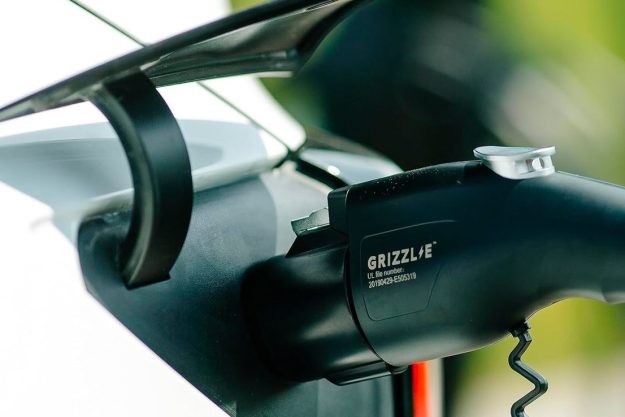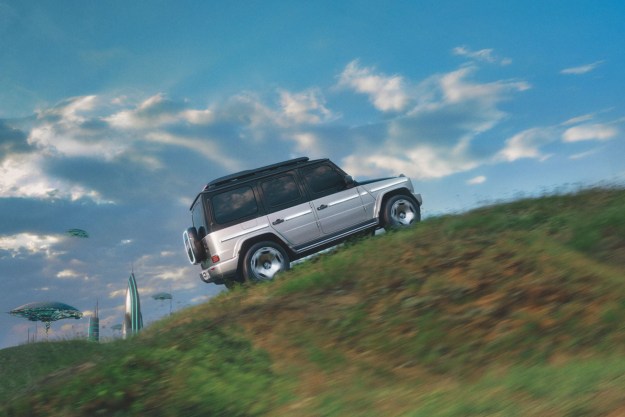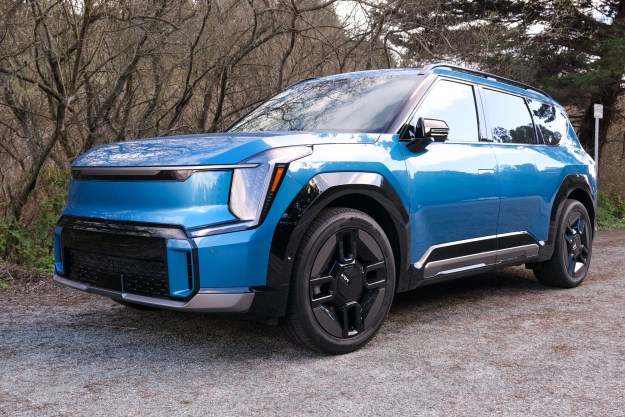
Digital Trends’ contributor Nick Jaynes covered the recent introduction of Jaguar’s new F-Type roadster from Spain but after driving it on American roads closer to our home base here in the Northwest, I wanted to take a loser look at what keeps Jag’s newest cat – and it’s first true sports car in many a year – glued to the pavement.
My recent seat time consisted of driving the $69,000 F-Type S with the supercharged V6 as well as the high-powered $92,000 V8 S model, so I can’t speak to the performance levels of the base model F-Type. However, our drive time through Washington’s Mount Rainier National Park and later on the Ridge Motorsports Park shows that Jaguar isn’t messing around as it re-enters the sports car market.
Quickshift transmission with Dynamic Mode
All variations of the new F-Types feature a front-engine, rear-wheel drive layout. Power is sent to the rear wheels via an eight-speed ‘Quickshift’ automatic transmission. Sports car traditionalists will invariably gripe at the omission of a clutch and stick shift option but the Quickshift setup, with its eight closely spaces ratios, allows for quicker, more accurate shifts, meaning a true manual option really wasn’t missed.
Indeed, Jaguar says the entire drivetrain of the F-Type has been optimized for instantaneous torque delivery, and it shows. Quickshift might sound gimmicky but while driving in fully automatic mode, the system is constantly calculating, mapping, and monitoring acceleration based on a number of driver metrics such as acceleration, cornering forces, throttle position, gear selection and brake pedal activity. What that translates to is a car that knows when to blip the throttle to match engine revs, provides rapid downshifts during hard braking and knows when to hold a higher gear – such as during aggressive cornering – so that the optimal gear is selected when powering out of the corner.

It all sounds rather complex but the best thing about Jaguar’s Quickshift system is how seamless – and quick – it is while driving.
The F-Type’s use of lightweight materials ensures an intricate balance of performance, ride comfort, and handling
For maximum performance, engaging Dynamic Mode is your best option. Located just to the left of the console-mounted shifter, and with a design inspired by a fighter jet’s toggle, Dynamic Mode remaps the car’s internal response parameters by pulling information from various sensors placed around the vehicle. These sensors monitor steering angle and rate, wheel speed , yaw/ g-force, brake pressure, even the position of the F-Type’s accelerator in order to sharpen driving characteristics in a number of ways.
For example, with Dynamic Mode toggled off, the accelerator’s response curve is less lively, which amounts to smoother, more controlled acceleration for normal driving. Toggle it on and that input becomes much more sensitive, resulting in faster, more direct acceleration required for a more sporting pace.

Dynamic Mode also exposes the F-Types claws by tightening up transmission shifts and steering output. In regards to the former, the F-Type’s transmission analyzes steering input and g-force, and will actually hold lower gears and upshifts, or delay them altogether, to ensure maximum power and acceleration out of a corner. The F-Type’s steering also stiffens up, resulting in a more connected feel to the road. Wheel speed data is monitored and calculated to ensure the appropriate amount of power is supplied for low-speed maneuvers.
Dynamic Mode works in concert with the F-Type’s Configurable Dynamics display, which maps out the systems various functions on the car’s 8-inch LCD touchscreen and lets drivers fully customize the car’s response to their taste. These include steering, throttle, and brake inputs, all of which can be adjusted. So for example, you can can tweak throttle response, making the car more or less sensitive when stepping on the gas and adjust steering weight, giving the F-Type’s steering a meatier weight and feel. You can also time your lap and measure G-forces, and a handy launch control mode, which Jaguar tells me can only be engaged when the F-Type is stopped, allows the traction and throttle control systems to operate at optimum launch traction for improved acceleration off the line.
You don’t have to engage Dynamic Mode to mine all the thrills from the F-Type but it helps, and I found myself hitting the switch every time I got in the car. It also helps that the F-Type forgoes the now popular electric power steering in favor of a less efficient, but more palpable hydraulic steering system. Whether on the track or road, the F-Type’ steering was tight and responsive and never approached the numb feeling of modern all-electric setups.
Adaptive Dynamics suspension system
Jaguar also bills its suspension system as ‘Adaptive Dynamics,’ which modifies a number of handling characteristics on the fly aimed at tailoring the car to your current driving conditions. Like the QuickShift transmission system, Adaptive Dynamics accomplishes its task by continuously monitoring vehicle metrics like speed, steering, and body movements through the car’s onboard computer, which can calculate appropriate suspension response up to 500 times per second. Variables like speed, steering and body movements are all analyzed on the fly, which in turn tweaks the suspension response and damping to match driving conditions. Stop-and-go city driving results in some additional cush for bumps and overall comfort while the suspension stiffens up on twisting back roads and hard cornering.
You don’t have to engage Dynamic Mode to mine all the thrills from the F-Type but it helps.
The system is very quick to react. Feel like mashing on the throttle and pouncing from a stoplight? The valves in the rear dampers constrict and the rear shocks stiffen to help keep the vehicle tight and composed all the way through heavy acceleration. About to do some heavy braking on a steep downhill? The F-Type’s front dampers likewise stiffen up to ensure suspension doesn’t compression too much. Prepping to hit a number of ‘S’ curves up that canyon road? The transmission and suspension system work in unison to ensure gear changes are held and maximum vehicle stability is provided, while outboard dampers tighten up to reduce body roll.
Out on the road, it all works brilliantly.
Different differentials, lighter weight
Handling and vehicle stability is also controlled by the F-Type’s limited-slip and active differentials. The limited-slip system is present in the F-Type S while the active version is employed in the top-line V8 S. Limited-slip differentials send rotational power (grip) to both wheels when one is raised off the ground or experiencing slippage. The active system in the V8 S takes this a step further by providing an electronically controlled differential that uses a multi-plate clutch to transfer torque to the wheel with the most grip. The V8 S’s active system works in conjunction with the car’s ABS, stability, and traction systems, ensuring torque is piped to the wheels with the most available grip. What that translates to on the road is a composed driving character even during the most challenging conditions.
But it’s not just the fancy tech under the hood that connects car and driver to the road. The F-Type’s use of lightweight materials ensures an intricate balance of performance, ride comfort, and handling. And because aluminum is both lighter and stiffer than conventional steel, it served as the perfect material to ensure the F-Type remained as lightweight as possible. The standard F-Type weighs in at 3521 pounds while the F-Type S and F-Type V8 weigh in at 3558 and 3671 pounds, respectively.

Jaguar’s engineers even managed to achieve a perfect 50/50 weight distribution in the V6 and it proved a smidge more refined than its V8-powered counterpart. the V8 version has a 51:49 weight distribution and doesn’t sashay in and out of corners quite as well as the V6.
The F-Type has another trick up its sleeve in the form of an electronically retractable rear spoiler that activates at speeds greater than 60 mph and returns flush when speeds drop below 40 mph. Many performance and sports cars now feature this trick bit and often, it’s more of an ego booster than true piece of performance technology. Does it look cool? Sure, but on the F-Type it also actually works, providing about 280 pounds worth of downforce at speed and giving the tires that much more grip.
Fierce competitor
Jaguar has made no bones about who it’s targeting with the F-Type but I’m not sure comparing it to a Porsche 911 is fair.
The F-Type is a brand new model, albeit one with decades of sports car pedigree behind it, while the 911 has been around for decades, maturing year by year. It’s often the benchmark to which all sports cars are measured. In time, and if Jaguar can continue its defiant march back into the “true” sports car realm, I don’t see why the F-Type can’t challenge the 911 for the sports car crown.
Jaguar’s combination of smart transmission and suspension technology has this cat in the fight from the get-go.


